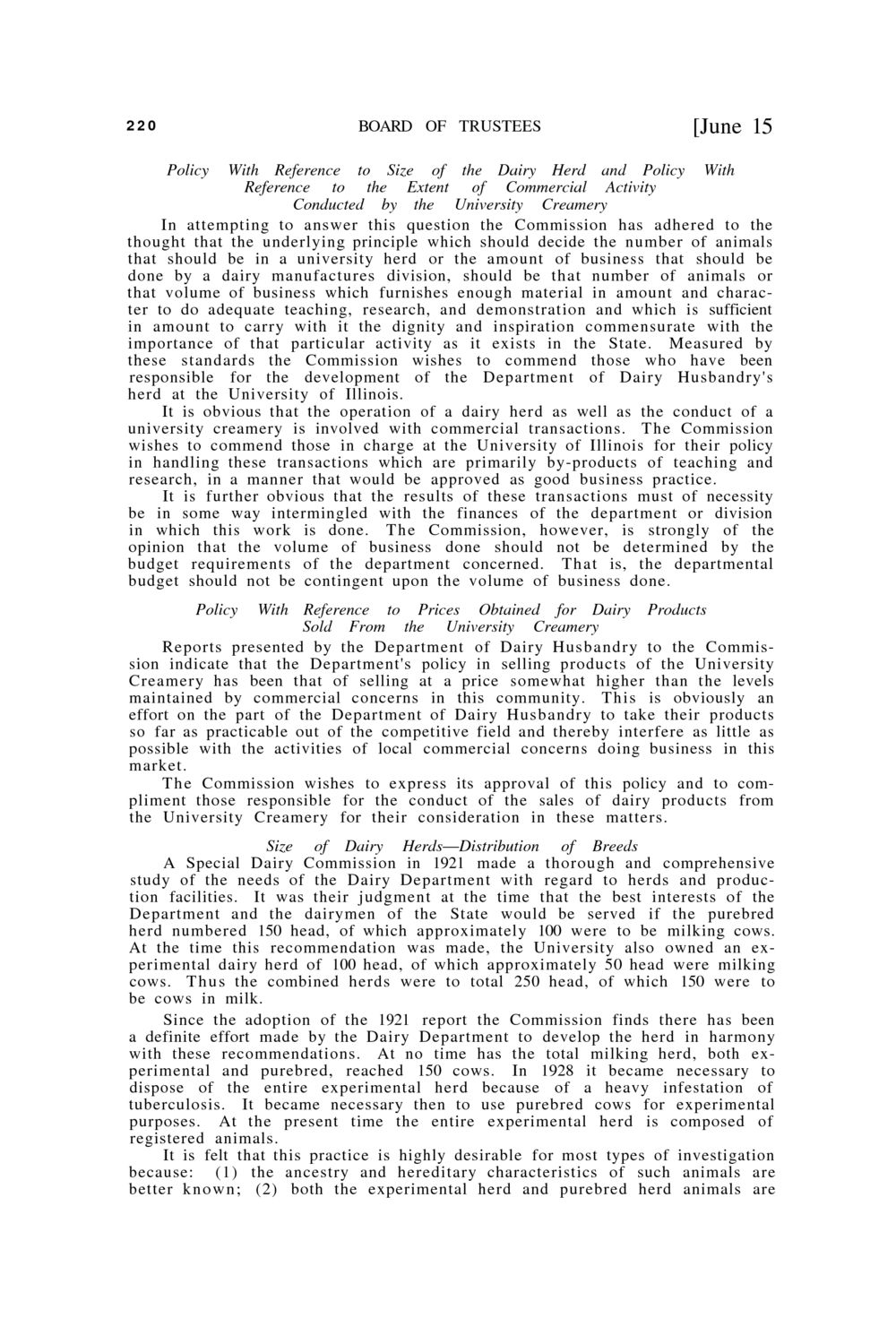| |
| |
Caption: Board of Trustees Minutes - 1936
This is a reduced-resolution page image for fast online browsing.

EXTRACTED TEXT FROM PAGE:
220 BOARD OF TRUSTEES Policy [June 15 With Reference to Size of the Dairy Herd and Policy With Reference to the Extent of Commercial Activity Conducted by the University Creamery In attempting to answer this question the Commission has adhered to the thought that the underlying principle which should decide the number of animals that should be in a university herd or the amount of business that should be done by a dairy manufactures division, should be that number of animals or that volume of business which furnishes enough material in amount and character to do adequate teaching, research, and demonstration and which is sufficient in amount to carry with it the dignity and inspiration commensurate with the importance of that particular activity as it exists in the State. Measured by these standards the Commission wishes to commend those who have been responsible for the development of the Department of Dairy Husbandry's herd at the University of Illinois. It is obvious that the operation of a dairy herd as well as the conduct of a university creamery is involved with commercial transactions. T h e Commission wishes to commend those in charge at the University of Illinois for their policy in handling these transactions which are primarily by-products of teaching and research, in a manner that would be approved as good business practice. It is further obvious that the results of these transactions must of necessity be in some way intermingled with the finances of the department or division in which this work is done. T h e Commission, however, is strongly of the opinion that the volume of business done should not be determined by the budget requirements of the department concerned. T h a t is, the departmental budget should not be contingent upon the volume of business done. With Reference to Prices Obtained for Dairy Products Sold From the University Creamery Reports presented by the Department of Dairy Husbandry to the Commission indicate that the Department's policy in selling products of the University Creamery has been that of selling at a price somewhat higher than the levels maintained by commercial concerns in this community. This is obviously an effort on the part of the Department of Dairy Husbandry to take their products so far as practicable out of the competitive field and thereby interfere as little as possible with the activities of local commercial concerns doing business in this market. T h e Commission wishes to express its approval of this policy and to compliment those responsible for the conduct of the sales of dairy products from the University Creamery for their consideration in these matters. Size of Dairy Herds—Distribution of Breeds A Special Dairy Commission in 1921 made a thorough and comprehensive study of the needs of the Dairy Department with regard to herds and production facilities. It was their judgment at the time that the best interests of the Department and the dairymen of the State would be served if the purebred herd numbered 150 head, of which approximately 100 were to be milking cows. At the time this recommendation was made, the University also owned an experimental dairy herd of 100 head, of which approximately 50 head were milking cows. T h u s the combined herds were to total 250 head, of which 150 were to be cows in milk. Since the adoption of the 1921 report the Commission finds there has been a definite effort made by the Dairy Department to develop the herd in harmony with these recommendations. At no time has the total milking herd, both experimental and purebred, reached 150 cows. In 1928 it became necessary to dispose of the entire experimental herd because of a heavy infestation of tuberculosis. It became necessary then to use purebred cows for experimental purposes. At the present time the entire experimental herd is composed of registered animals. It is felt that this practice is highly desirable for most types of investigation because: (1) the ancestry and hereditary characteristics of such animals are better k n o w n ; (2) both the experimental herd and purebred herd animals are Policy
| |